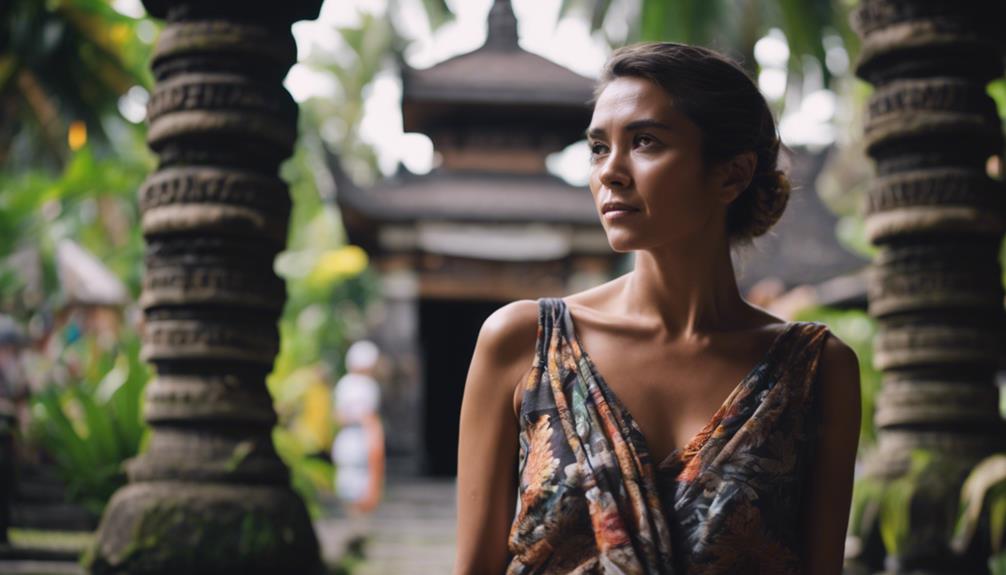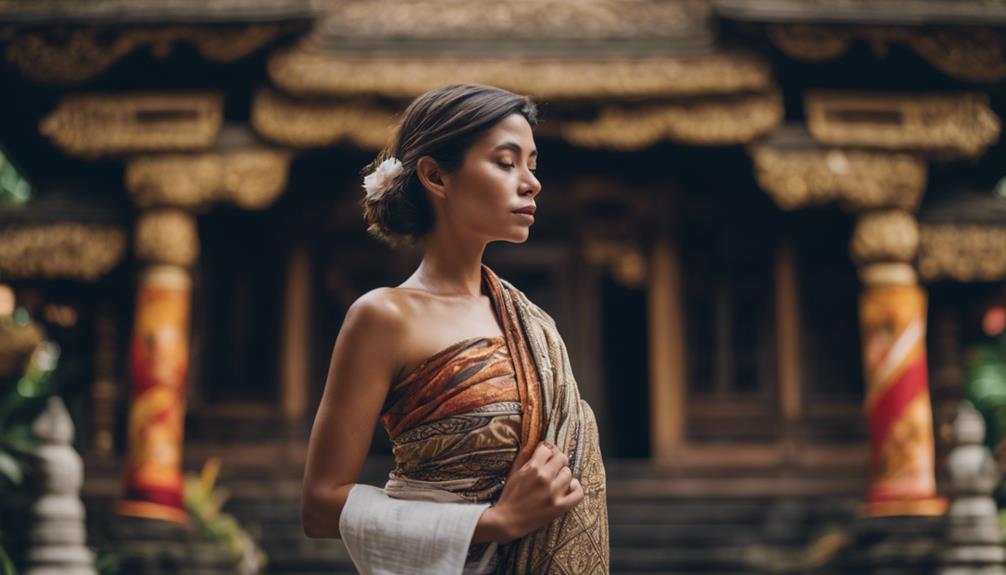Can I Show My Shoulders in Bali?
Imagine you've packed your suitcase to the brim with your favorite shoulder-baring outfits, only to find out that in Bali, this fashion choice could be a cultural misstep.
Bali, with its rich cultural heritage and highly revered temples, requires some understanding and respect for its dress codes.
So, can you show your shoulders in Bali? Well, it's not as simple as a yes or no answer.
Stick around, as we are about to explore this interesting aspect of Balinese culture.
Key Takeaways
- In temples, villages, and markets, covering shoulders is a sign of respect to Balinese culture and religious customs.
- Beaches offer more flexibility, allowing more relaxed attire, including shoulder exposure.
- Combining personal style with traditional Balinese attire like sarongs and kebaya is encouraged, especially in religious settings.
- Balancing comfort and cultural sensitivity is key, with lightweight materials and local fashion trends fitting Bali's climate and norms.
Understanding Balinese Culture

Delving into Balinese culture, you'll quickly realize it's a fascinating blend of spirituality, tradition, and respect, where even the simplest acts like clothing choices can carry deep significance. Each aspect of their lifestyle reflects a deep understanding and appreciation of the world around them, including their artistic expressions and dining proof.
In Bali, artistic expressions aren't just decorative embellishments, but they're interwoven with religious ceremonies and daily routines. You'll find artistry in their dance forms, intricate carvings, and even in their meals. Yes, food, too, is an art form. The Balinese dining proof is a confirmation of their innovative spirit. Each meal is an immersive experience where the flavors, presentation, and even the seating arrangement carry symbolic gestures.
It's not just about consuming food, but more about engaging with others and acknowledging the divine blessings. So, you'll notice that in Bali, dining is often communal, and it's customary to wash hands before and after eating. This not only signifies cleanliness but also respect for the food and the company you're with. All these nuances are just a glimpse into the rich tapestry that's Balinese culture. You're invited to explore, respect, and appreciate it.
Dress Code in Bali
When you visit Bali, understanding the local dress code is essential to show respect for its rich cultural heritage. Remarkably, this includes awareness of the religious dress code and local cultural norms, especially when you're visiting temples.
Bali's Religious Dress Code
In the heart of Bali, you'll need to adhere to a specific dress code rooted in the island's deep religious beliefs. The religious symbolism and modesty significance are key in understanding the Balinese dress code.
- Religious symbolism: Bali is mainly Hindu, and their clothes often reflect the sacred symbols of their faith.
- Modesty significance: Covering the shoulders and knees is a sign of respect in temples and holy places.
- Adaptive innovation: Modern interpretations allow for style and comfort without compromising respect for tradition.
Local Cultural Norms
Exploring Bali's local cultural norms, you'll quickly notice that the dress code extends beyond religious sites and is deeply ingrained in everyday life. Modesty is valued, and revealing clothing is generally frowned upon, especially in rural areas.
Cultural gestures and community traditions shape these norms substantially. For instance, Balinese women often wear a kebaya, a traditional blouse, and men wear sarongs for special occasions. It's not just about clothing, but also about respecting the local customs.
Dressing for Bali Temples
Dressing appropriately for Bali's temples might seem like a challenging task, but showing respect for the local culture and traditions is important. Understanding Temple Clothing Styles and Traditional Balinese Attire will help you navigate this with grace. Here are some key points to remember:
- Always cover your shoulders and knees. Sarongs are often provided, but bringing your own guarantees you're always prepared.
- Avoid overly tight or revealing attire. Modesty is highly valued in Balinese culture.
- Traditional Balinese Attire, such as a Kebaya blouse and sarong, is often worn for ceremonies.
When you dress respectfully, you're not just complying with a dress code, you're acknowledging the spiritual significance of these sacred spaces. So embrace the opportunity to express your respect and appreciation for Bali's rich cultural heritage.
Showing Shoulders: Yes or No?
Should you show your shoulders in Bali?
The answer isn't as simple as 'yes' or 'no'.
It's important for you to take into account Bali's dress code norms and show respect for local customs.
Bali's Dress Code Norms
When it comes to showing your shoulders in Bali, it's more about where you're than a significant yes or no answer. Bali's dress code norms are generally relaxed, especially in the bustling areas of Kuta and Seminyak. Here, the Bali nightlife attire can be a little more critical, giving you a chance to show off your style.
However, it's essential to contemplate three key points:
- Shopping for clothes in Bali offers a range of lightweight, stylish options, perfect for the tropical climate.
- Many higher-end venues and restaurants require a more conservative dress code.
- Beachwear is acceptable on the beach, but less so in small towns and villages.
Understanding Bali's dress code norms will help make your stay more enjoyable and respectful.
Respect for Local Customs
While you're getting to grips with Bali's relaxed dress norms, it's also important to recognize the local customs, particularly when it comes to showing your shoulders. Customs sensitivity means understanding and respecting these norms, as part of your cultural immersion experience.
Here's a quick guide:
| Setting | Shoulder Exposure |
|---|---|
| Temples | No |
| Beaches | Yes |
| Markets | Yes, with caution |
| Villages | No |
In temples and villages, cover your shoulders out of respect. At beaches, you're free to dress down, but when visiting markets, be mindful as you're stepping into their everyday life. It's about striking a balance between comfort and respect. Your sensitivity to these customs, no doubt, enhances your experience and relationship with the local community.
Temple Etiquette in Bali

Often, you'll find that maintaining modesty is key when visiting temples in Bali, so it's important to cover your shoulders and knees as a mark of respect. This isn't just about following rules, it's about immersing yourself in the Balinese culture and honoring their customs.
Balinese Temple Architecture is as much about spiritual significance as it's about aesthetics. You'll notice intricate carvings, towering gates and multi-tiered shrines, each element having a unique purpose and meaning.
Balinese Ritual Practices, too, are deeply symbolic. Prayers, offerings, and processions are integral parts of temple visits. You'll often see locals wearing traditional attire, presenting flower offerings, or participating in purification rituals.
Remember these points when visiting temples:
- Dress appropriately: cover your shoulders and knees.
- Don't disrupt any ongoing ceremonies or prayers.
- Respect the sanctity of the space: refrain from touching sacred objects or climbing onto structures.
Beachwear Guidelines in Bali
Shifting gears from temple etiquette, let's now explore the beachwear guidelines in Bali, where the rules are different, but respect for local customs still holds importance. On Bali's beaches, you've got more leeway when it comes to showing skin. So don't be shy consider embrace the latest swimwear trends. Just remember: While bikinis and board shorts are widely accepted, nudity isn't. So make sure your beachwear covers the essentials.
Still, it's not all about fashion. Protecting your skin from the sun's harsh rays is also key. With Bali's tropical climate, you'll need consider innovative sunscreen options. brands that aren't only effective but also eco-friendly. Coral-safe sunscreens, for example, protect your skin while preserving the island's delicate marine life.
Also, remember consider pack a cover-up for when you leave the beach. It's a simple act of respect that goes a long way in respecting the local culture.
In short, when you're on Bali's beaches, feel free consider enjoy the sun and sea, but do so in a way that's mindful of local customs and the environment. It's about finding that perfect balance between personal comfort, style, and respect for Bali's unique culture.
Respectful Attire in Public Spaces

Venturing away from the beach and into Bali's public spaces, it's important to remember that dressing respectfully isn't just appreciated but expected. Your attire should reflect both understanding and respect for the local customs and Public Decency Laws.
Keep in mind, dressing appropriately isn't about stifling your personal style. It's about blending your innovative fashion sense with a deep respect for Balinese traditions. Cultural Sensitivity Training can be a great way to learn more about the local norms and expectations.
Here are some general guidelines to follow:
- Do cover your shoulders and knees, especially when visiting temples and sacred sites.
- Don't wear beachwear or revealing clothing in public areas, like markets or streets.
- Do consider wearing clothing made from lightweight, breathable materials to maintain comfort in Bali's tropical climate.
Tips for Dressing Appropriately in Bali
To guarantee your wardrobe aligns with Bali's customs, it's important to contemplate a few key tips when choosing your attire for this beautiful island.
First and foremost, consider the Balinese Fashion Trends. Subtle elegance is the mainstay here, with white linen or cotton being popular fabric choices. Traditional attire often incorporates batik and ikat prints, which you'll find aplenty while shopping for clothes in Bali.
However, don't be afraid to experiment. Bali's rich textile scene encourages innovative fashion choices. It's all about blending the traditional with the modern. Try pairing a batik sarong with a minimalist top, or vice versa.
Respect for local customs is essential. When visiting temples, cover your shoulders and knees. Sarongs are often provided at entrances, or you can bring your own.



